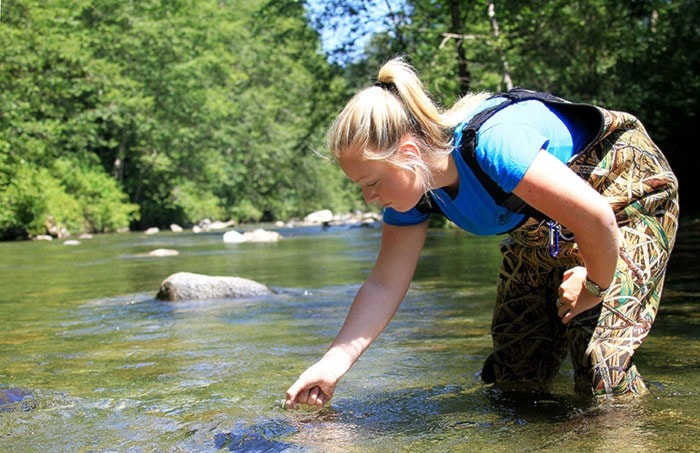Temperatures are baking and there’s no rain in the making, but the fish in the South Alouette River are surviving, thanks to the river – just being a river.
The outlet from the Alouette Lake reservoir is maintaining a minimum flow and trees and bushes along the river bank are cooling the water and insulating young salmon from possibly fatal jumps in water temperature.
“We’re definitely checking it here, and it, of course, is warmer than usual,” said Nicole Driedger, interim director of ARMS.
“We’re not sounding alarm bells yet.”
She said two weeks ago, on June 22, the water temperature in the South Alouette River at Allco Park hatchery at the north end of 248th Street was 17 C.
On July 3, the temperature was 21 C. “The fish start stressing at 23 C and they start dying at 25 C.”
Coho and chum fry were released into the river earlier this spring, while the wild coho wait around a year before making a run for the open Pacific Ocean.
“They’re still alive, so obviously, the river is doing its job.”
Driediger said the outflow from Alouette Lake is below the surface level, which means the water that’s running out of the dam is cooler than at the surface. Then, as the water flows down the river, it’s cooled some more thanks to vegetation above, in and around the river.
However, the temperature of water that’s being released could increase as the lake level drops. There’s no snow melt, after a warm and dry winter, to feed into the lake.
“It’s extremely important not to cut down a whole bunch of vegetation,” said Driedger.
Then water temperatures would climb, she added.
“It is, ecologically, doing well,” Driediger said of the river system.
“We’ll hit the panic button if we don’t get the fall rains, because the fall rains bring the fish back.”
She also referred to a recent meeting by the Alouette monitoring committee, which also said river conditions were adequate.
Since 1999, there have been only 35 days when the recorded water temperature for the entire South Alouette was higher than 21 C.
She didn’t know about the conditions of the North Alouette River, which is naturally fed by the watershed instead of the reservoir.
It’s a scarier story in the Kanaka Creek system, says Ross Davies, with the Kanaka Education and Environmental Partnership Society. “We haven’t had a stretch like this ever – that I can remember.
“I can’t stress enough, this is off the charts.
“You get the sense that something has changed, something is wrong.”
He’s lived in Maple Ridge since 1988 and has never seen the 38 C temperatures he saw Sunday.
Davies said that temperatures in Kanaka Creek, upstream of the Bell Irving Hatchery on 256th Street, hit 23 C for a few hours in the afternoon. Then the waterflow from the ground-fed tributaries cooled it down.
“This year, for all intents and purposes, summer started in April and it’s just sort of gone from there.”
The steam flow is about a third of what is usually is, he added.
Juvenile salmon in the stream could see their numbers drop as more die from predation.
But if the fall rains return and stream levels come back to the usual levels, the returning salmon will be able to get up the stream to spawn.
For the next week at least, there’s no change expected in the sunny, hot weather according to Environment Canada.
Davies said baby salmon are trying to get out of the main stem of Kanaka, where daytime temps reach about 20 C, into the smaller tributaries, such as Thornvale Creek, which are spring fed and have cooler water at 17 C. But the smaller streams mean fish are more visible to other creatures looking for a snack.
“They’re really looking for cooler water so they’re more vulnerable to predators right now.”
